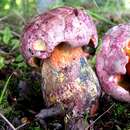en
names in breadcrumbs


Rubroboletus is a genus of bolete fungi in the family Boletaceae. It was circumscribed by Chinese mycologists in 2014 with Rubroboletus sinicus as the type species. Species are characterized by having a reddish cap surface, yellow tubes on the underside of the cap, and an orange-red to blood-red pore surface. Pinkish to red spots (reticula) are present on the stipe surface, and a bluish color change occurs when the bolete flesh is injured. Rubroboletus mushrooms have an olive-brown spore print, and produce smooth spores.[1] Eight species were included in the original circumscription (seven new combinations and one new species); five were added in 2015,[2][3][4] and another in 2017.
Although R. sinicus is sold in markets in Yunnan, China, the whole genus is usually deemed poisonous.[1]
Rubroboletus is a genus of bolete fungi in the family Boletaceae. It was circumscribed by Chinese mycologists in 2014 with Rubroboletus sinicus as the type species. Species are characterized by having a reddish cap surface, yellow tubes on the underside of the cap, and an orange-red to blood-red pore surface. Pinkish to red spots (reticula) are present on the stipe surface, and a bluish color change occurs when the bolete flesh is injured. Rubroboletus mushrooms have an olive-brown spore print, and produce smooth spores. Eight species were included in the original circumscription (seven new combinations and one new species); five were added in 2015, and another in 2017.
Although R. sinicus is sold in markets in Yunnan, China, the whole genus is usually deemed poisonous.